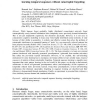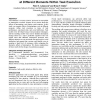96 search results - page 6 / 20 » Cognitive Models of Test-Item Effects in Human Category Lear... |
CONNECTION
2004
13 years 7 months ago
2004
While humans forget gradually, highly distributed connectionist networks forget catastrophically: newly learned information often completely erases previously learned information. ...
CHI
2004
ACM
14 years 7 months ago
2004
ACM
User attention is a scarce resource, and users are susceptible to interruption overload. Systems do not reason about the effects of interrupting a user during a task sequence. In ...
EDM
2008
13 years 8 months ago
2008
Using data from an existing pre-algebra computer-based tutor, we analyzed the covariance of item-types with the goal of describing a more effective way to assign skill labels to it...
BVAI
2007
Springer
14 years 1 months ago
2007
Springer
We tested the efficiency of category learning when participants are provided only with pairs of objects, known to belong either to the same class (Positive Equivalence Constraints ...
HCI
2009
13 years 5 months ago
2009
Responsive Adaptive Display Anticipates Requests (RADAR) is a domain general system that learns to highlight an individual's preferred information displays, given the current ...


